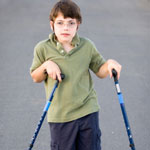Cerebral Palsy Lawsuit Ends in $4 Million Settlement
 A malpractice claim against Kaiser alleging birth injuries has been settled for $4.1 million. The woman who filed the claim is the great grandmother and guardian ad litem to a seven-year-old boy diagnosed with spastic cerebral palsy and epilepsy.
A malpractice claim against Kaiser alleging birth injuries has been settled for $4.1 million. The woman who filed the claim is the great grandmother and guardian ad litem to a seven-year-old boy diagnosed with spastic cerebral palsy and epilepsy.
The plaintiff claims a delay of a number of days in the birth of the child led to his birth injuries.
Cerebral palsy lawsuit filed in San Francisco
The woman, Delores Lee, filed her cerebral palsy lawsuit in San Francisco County Superior Court. Lee states the mother of the child showed “signs and symptoms” of labor for a number of days before Kaiser admitted her for delivery of the baby. The significant delay caused “catastrophic injuries” to the boy, which require round-the-clock care to this day.
At the age of seven, Demorea Ferdinand is still unable to walk, crawl or communicate. The child is dependent on others for every activity in his life. His severe global developmental delay requires 24-hour supervision, as he is unable to follow any type of commands or instructions.
Kaiser agreed to pay the plaintiff $4.1 million to compensate for medical treatment and ongoing care required by the child due to his cerebral palsy birth injury. Defendants listed on the complaint included Kaiser Foundation Hospitals, Kaiser Foundation Health Plan Inc. and the Permanente Medical Group. A petition to approve the settlement was filed in the Superior Court on February 7, 2014 after Lee agreed to the settlement terms.
About cerebral palsy
Cerebral palsy is a movement disorder that originates with damage in the brain. The condition can occur while the fetus is in utero or during the labor and delivery process. In rare cases, cerebral palsy can also develop after the child is born. Causes of cerebral palsy might include oxygen deprivation during delivery. Other causes include meningitis, infection and head trauma after birth. During pregnancy, improper development of blood vessels leading to the brain or the brain itself can lead to cerebral palsy.
Cerebral palsy is not usually diagnosed until a child is a few years old, with early signs typically appearing before the age of three. It is often accompanied by other medical conditions, such as seizure disorders, feeding problems or other developmental delays. There is no cure for cerebral palsy and treatment effectiveness will depend on the severity of the condition. In some cases, ongoing care is required to keep the patient safe and healthy if the patient is unable to care for himself.
There are different types of cerebral palsy, including ataxic, athetoid and spastic. Spastic cerebral palsy like Ferdinand’s is characterized by underdeveloped limbs and rigid joints. It may affect just two of the limbs or all of them, a condition known as quadriplegia. The majority of individuals diagnosed with cerebral palsy (70%) have the spastic type. Some have a combination of various types, known as mixed cerebral palsy.
Some diagnosed with cerebral palsy will be able to talk, communicate and lead a relatively independent life. Others, like Ferdinand, will likely need 24-hour supervision throughout life. Medications, surgeries and other medical treatments might be used to improve the quality of the patient’s life. The cost of caring for someone with severe cerebral palsy can be astronomical and may create a severe financial strain for the patient and the entire family.
Stanford University Medical Center testified in a letter to the court that Ferdinand requires constant supervision and care, due to his cerebral palsy and accompanying medical conditions.


